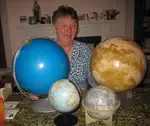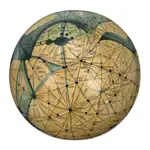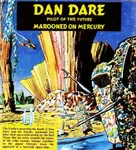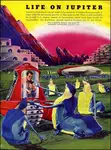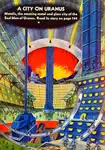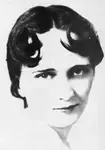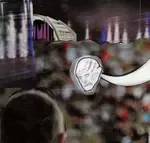what to see on
callisto
For a scenic browse, and an answer-page for Guess The World...
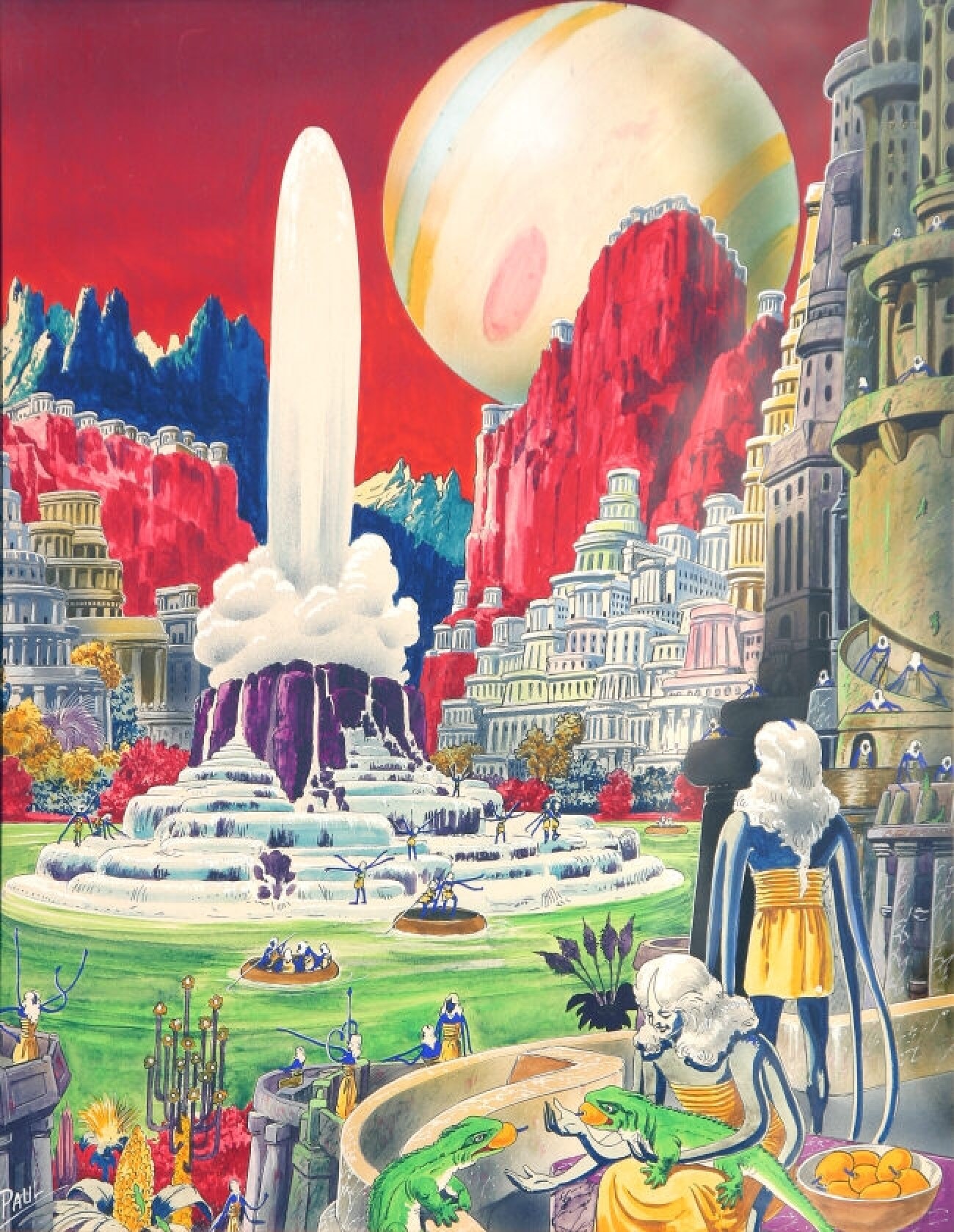 Serenis, water-city of Callisto, by Frank R Paul
Serenis, water-city of Callisto, by Frank R Paulgiant callistan caterpillars
...I wheeled in dismay and remained petrified at the sight before my eyes.
The surface of the lake was broken into boiling foam, and from it there reared the fore-parts of what appeared to be giant caterpillars. They squirmed out upon land, dirty-gray bodies dripping slime and water. They were some four feet long, about one foot in thickness, and their method of locomotion was the slowest of oxygen-conserving crawls. Except for one stalky growth upon their forward end, the tip of which glowed a faint red, they were absolutely featureless.
Even as I watched, their numbers increased, until the shore became one heaving mass of sickly gray flesh..
Isaac Asimov, The Callistan Menace (Astonishing Stories, April 1940)
callistan arthropod tribe
...My first reaction to the arthropods was, as I have said, one of revulsion at what I deemed their hideous and inhuman aspect. Inhuman they certainly were, but "hideous" is a matter of open question. The fact that they differed enormously from Homo sapiens was no reason to find their appearance automatically loathsome. Very soon I found myself admiring them. Slim, stalking figures, they were not without a certain grace - even a certain cold inhuman beauty. With their attenuated limbs and extreme height they came, with familiarity, to assume something of the dignity and impressiveness of the lean gaunt statues of Giacometti or Henry Moore's weird stone figures.
Indeed, they had also something of the sleek, economical efficiency of a well-designed machine. Almost I could picture those stalking, multijointed limbs as smoothly machined pistons. Something of the passionless beauty of the machine was theirs, and something of the grandeur of sculpture.
In short, I no longer found them frightening, having no reason to fear my fate at their hands...
Lin Carter, Jandar of Callisto (1972)
and see Thanator - For and Against
mush-and-crust callisto
It had almost no atmosphere, just a thin layer of the heavier gases. It was a belted world, without clearly defined continents or surface markings. Its equatorial zone was one vast, featureless belt of darkish-gray. Its temperate zones were white, with patches of yellow here and there. But its poles were gray again.
"The satellite's like a huge ball of thin mud that's never hardened," said Burl as they studied the strange terrain.
"The equator's the softest - it seems to be a river of muddy water, hundreds of miles wide - only it can't be water. Probably semisolidified gases holding dust and grains of matter in suspension," said Russ. "The temperate zones are the same stuff, only colder, and therefore more stable. A thin crust of frozen gases over a planet-wide ocean of semiliquid substance."
"The Sun-tap station's on the southern pole," said Burl. "That must be solid."
It
was. The poles... were actually two continent-sized islands of shell.
Dry, mudlike stuff, hard as rock, floating on the endless seas of the
semiliquid planet...
Donald A Wollheim, The Secret of the Ninth Planet (1959)
creeping crystals of callisto
"Lad, it's time we left," rasped Simon Wright's warning. "The crystals are coming too near."
Curt whirled. The cataract of brilliant crystals was now pouring steadily across the rocky plains toward them. The gleaming, faceted crystalline things advanced inexorably, motivated by an electric force in their strange organic bodies that gave them the power of attraction and repulsion to each other.
With a clicking, murmuring, rustling sound, the brilliant flood moved at the rate of a few feet a moment, each separate gleaming crystal jerking a few inches forward by exerting repulsion upon those behind it. They were but a hundred feet away.
"Grag, wreck the cyclotrons of this ship!" Captain Future ordered. "Then we'll be off."
As the big robot sprang into the black craft to obey, Orris and Skeel voiced wild protest.
"You're not going to leave us here to be killed by those things!" they cried.
Curt bent over the two helpless men and touched their nerve-centres, lifting the paralysis that held them. As they staggered up, Grag came out of the ship.
"It is wrecked, master," boomed the robot. "That ship will not fly space again."
"You two men can run now, and you can easily keep away from the crystals here," Curt told Orris and Skeel. "I'll notify the Planet Police at Jovopolis and they'll send a ship out to pick you up."
His eyes flamed.
"If I did what I'd like to, I'd let the crystals have you! You've helped to spread a horror that's blacker than murder!"
The
two criminals stared wildly at the clicking, advancing flood of
crystals now only fifty feet away, and then broke into a crazy run in
the opposite direction, stumbling frantically away across the drab gray
desert.
Edmond Hamilton, Captain Future and the Space Emperor (1939)
flying over an ocean on callisto
It was with keen interest that
the occupants of the "Meteor" examined the chart which Thard spread
before them. From it they saw that Callisto was mostly covered by water and
that, with the exception of a few small islands, there were but two continents.
These were Dassan and Anurdi, and Thard pointed out that Viljon, which they
were just leaving, was close to the seacost.
So it was that they soon headed over the great sea of Pasara, as it was
designated by Thard, with the fleet stringing along behind its tiny flagship.
The journey was one of about three thousand miles, as nearly as Ray could
estimate from the supposed diameter of Callisto, so he set the speed at five
hundred miles an hour in order to reach their destination in six hours.
The ocean, strangely, showed a muddy red-brown, instead of the deep
greenish-blue of the oceans on earth. Of course the weather was extremely cloudy
and that had some effect on the apparent color of the water, but he and Gary
decided that it was mainly due to a high concentration of certain minerals in
solution or in suspension, possibly iron oxides. The surface was troubled and
choppy, though there was very little wind, but Thard did not seem to be
concerned about the weather so the Tellurians presumed that conditions were
more or less normal for the world they were visiting.
Ray made some tests of the outside atmosphere and found that it was of nearly
same density and composition as that of the earth. However he found some
peculiarities in the gravity of Callisto which could only be accounted for on
the assumption that there was a gravity force separate and distinct from that
due to the mass of the body alone. The altimeter depended on normal earth
gravity and, while the surface gravity of Thares appeared to be about the same
as that of Tora, its indications became widely erroneous when at any
considerable altitude. The force did not vary inversely as the square of the
distance from the body, but at a much higher rate, thus confirming Ray's
previous supposition, that there was a supplementary force which accounted for
the high surface gravity of so small a body and its retention of so
considerable an atmosphere. Thus they learned later was due to an extremely
high percentage of magnetic ores in the interior of the body; the peculiar
properties of whose magnetic fields were quite similar to the artificial
gravity set up by the G-rays.
When they approached the shores of Dassan the skies were clearing, and soon the
sun shone forth weakly, as if it were some infinitely remote body, that seemed
scarcely akin to the sun that shone on Earth. But the temperature of the air
was nearly eighty degrees, and the two scientists from Tora were forced to the
conclusion that it was warmed by the internal heat of the satellite. They later
learned that the assumption was nearly correct, although the warm climate of
Thares was actually brought about by the presence of huge deposits of
radioactive minerals near the surface, rather than by the high temperature of a
molten interior. The waters brightened somewhat with the coming of the noon-day
sun, though they still retained the red-brown color to a great degree. The sun itself
was almost at the zenith, thus indicating that about half of the long
Callistonian day had passed - half of a day which, in earth time, was the
equivalent of more than sixteen and a half days. Darkness would not come for a
long time.
Harl Vincent, Callisto At War (Amazing Stories, March 1930)
>> Guess The World - Third Series
evolution on callisto
“…We were an active race; then as our world and the primary cooled we used our bodies less and less. Nature, ever adaptable, gave us bodies that were able to deal with the changing conditions, until there came the final species of hydrogen breathers, like me. I am the last. Intelligence of surpassing power – but physical ability nearly gone. Held in place only until I master it.”
“You want to die?” Clark demanded.
“One day. I shall stay here and brood until the time when I detach mind from body, limb by limb, organ by organ. That may mean ages; it may be tomorrow.”
…There was another silence and the three stood looking at each other. They were each thinking the same thing – the possibility of earthly life perhaps ending in such a creature as this – hideous, incredibly intelligent, impartial, brooding alone in a forgotten cave amid sub-zero cold. There was something terrifying about the thought. The pooling of endless ages of knowledge and culture into the brain pan of a gargoyle.
Henshaw broke the silence with a comment. “What d’you say we call him ‘Zero’?” he suggested, grinning. “A step removed from Nero, who fiddled instead of brooding. Huh?”
“Good name, but this is no time for levity,” Clark answered seriously. “Zero here brings home pretty forcibly the pointlessness of earthly struggle – of anybody’s struggle, for that matter. And besides – “
He broke off and twisted round at a sudden noise. He stared unbelievingly at the cave entrance, seeing for the first time that it was blocked with stunted, hideous creatures, all mouth and ears, on blocky legs with short bodies. Wicked little eyes glinted in the torchlight. Every head was totally bald.
“Magnified germs, so help me!” Henshaw gasped – and his simile was oddly accurate. The things certainly looked like the real thing from a preventative advertisement.
“The others of my race – de-evolved,” stated Zero placidly…
Thornton Ayre (= John Russell Fearn), Domain of Zero (Planet Stories, Fall 1940)
>> Guess The World - Third Series
stampeding bird-horses of callisto
…Strolling down one of the broad, tree-lined avenues of the Golden City of the Ku Thad, I heard cries of distress.
Gazing ahead, I perceived a chariot with a single passenger. The team of matched thaptors drawing the chariot were out of control, hurtling and careening down the boulevard at breakneck speed. At any instant, the chariot might overturn as its wheel caught an irregularity in the pave, thus hurling the chariot’s occupant to the pave and dealing him a serious injury.
The thaptors might have stampeded from any one of a number of causes – a chance noise, a sudden movement, a flick of the whip on some tender portion of their anatomy, or sheer cantankerousness alone. For the weird bird-horses of Thanator have never been fully domesticated and are restive and unruly, and quite likely to bolt or to turn upon their rider on chance whim or the slightest provocation…
Lin Carter, Black Legion of Callisto (1972)
>> Guess The World - Fourth Series
amid a crowd of four-armed folk on callisto
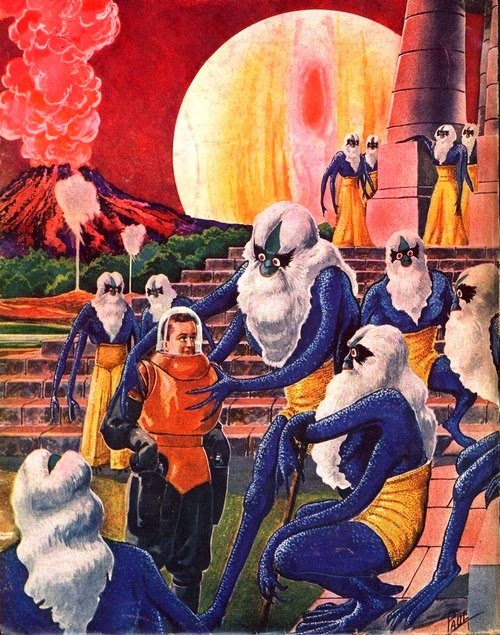 Frank R Paul, "Life on Callisto" (1940)
Frank R Paul, "Life on Callisto" (1940)>> Guess The World - Fourth Series
borne aloft in the skies of callisto
Thrice the Jalathadar circled the stone-walled city of the Ku Thad, gaining altitude with each swing around the city. The streets shrank below us – the palaces and mansions and citadels of Shondakor dwindled. The mighty throng became a many-colored carpet filling the squares and rooftops. We could see the glittering curve of the great river that flows by Shondakor, and from our ever-growing height the dark mass of foliage that was the immense jungled tract of the Grand Kumala became dimly visible on the horizon.
When we had ascended to the height of about half a mile, I gave the appropriate commands. The galleon leveled off and pointed her ornate prow north and west, in the general direction of the mountain country wherein Zanadar rears her castled crest. The wheel gangs settled down to a steady rhythm, the huge vans beating slowly, the enormous rudder holding the ship of the skies steady on her course.
I leaned against the carven rail, staring down at the broad meadows that slowly passed by far underneath our keel. Soon we would be beyond the measureless plains and flying above the great jungles…
Lin Carter, Sky Pirates of Callisto (1973)
>> Guess The World - Fifth Series
Comment by Zendexor: Re the Thanator series, I remember once reading a short spoof (I've forgotten the author's name) called Gongo of Ganymede...
ski-crash with a native of callisto
…The ground levelled out – the end of the course. I raised an arm in victory and looked back at Scott as I snow-plowed my skis to slow down…
“Look out!” Scott’s voice crackled over the radio.
Too slow, I swiveled my head to face front. A waist-high four-legged robot was directly in my path…
…the robot had recovered itself and was waving its four arms at us, trying to get our attention. The robot’s body looked like a pair of inverted cones surfaced with highly reflected glass, one cone nested partially inside the other, like a shiny, upside-down Christmas tree. Its arms and legs sprouted from rings around the widest part of each cone – four legs from the lower cone’s ring and four arms from the upper cone. Atop the upper cone was its squat, cylindrical head, which was also mirrored glass except for a short antenna…
…(I keep calling it a robot. The truth is that the Callisti are much stranger than robots, but they look outwardly like robots so, like most tourists on Callisto, I tended to think of them that way.)
Troy Jones III, The Sarcastic Snake-Men of Neptune (J M Gree and Zendexor, eds.,
Vintage Worlds 2 (2020))
>> Guess The World - Fifth Series
belted and crusty callisto
…despite its size, Callisto was apparently not a solid body as we think of it. Its density totaled only a little more than that of water, its mass half that of the Earth’s Moon – a notoriously porous body.
They bore down on Callisto, matching their speed to its, and swung close to its surface. It had almost no atmosphere, just a thin layer of the heavier gases. It was a belted world, without clearly defined continents or surface markings. Its equatorial zone was one vast featureless belt of darkish-gray. Its temperate zones were white, with patches of yellow here and there. But its poles were gray again.
“The satellite’s like a huge ball of thin mud that’s never hardened,” said Burl as they studied the strange terrain.
“The equator’s the softest – it seems to be a river of muddy water, hundreds of miles wide – only it can’t be water. Probably semisolidified gases holding dust and grains of matter in suspension,” said Russ. “The temperate zones are the same stuff, only colder, and therefore more stable. A thin crust of frozen gases over a planet-wide ocean of semiliquid substance…”
…The poles of Callisto were actually two continent-sized islands of shell. Dry, mudlike stuff, hard as rock, floating on the endless seas of the semiliquid planet…
Donald A Wollheim, The Secret of the Ninth Planet (1959), p.103-4
>> Guess The World - Fifth Series
winged foes on callisto
…In an instant, my
headlong plunge into the abyss was abruptly checked as the parrot-beaked
creature which held me tightly in the grip of its hooked claws spread wide its
indigo-plumed wings and broke our fall.
The winged man swooped away to the left in a steep, sickening
glide. Blinking away the tears the
fiercely-cold wind brought to my eyes, I saw ahead of us the other survivors of
the battle on the bridge…
Striving with watery eyes to
penetrate the dim gloom made bewildering by the tangle of colored moon-rays, I
saw we swooped giddily over a tortured landscape of naked rock, carved into
precipitous chasms and thronged with a fantastic maze of peaks and pinnacles. In another moment I was hopelessly lost, and
could not guess in which direction we flew, nor in what position the armada
might be found… In a few moments we were
among the fang-like peaks. They rose all
about us like the stalagmites in a mighty cavern, or a towering forest of
petrified trees…
Lin Carter, Mind Wizards of Callisto (1975)
>> Guess The World - Sixth Series





